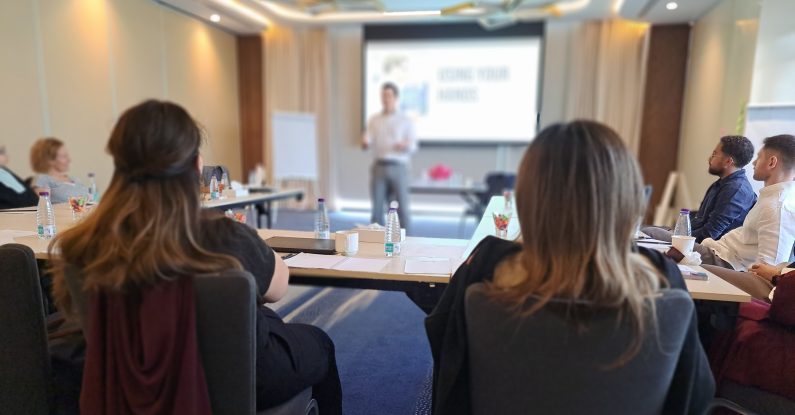
We’ve run presentation skills training in 26 countries around the world.
From Cannes to Cardiff and from New York to Newport.
Everywhere we go, we encounter the same key issues.
Namely: the battle between nerves and confidence.
You, the speaker, may know your material inside out.
But how do you react when someone senior at the back visibly yawns?
How do you deal with the balance of using your notes versus making eye contact?
And how do you manage the rush of adrenalin, the pumping heart, and the dry throat?
Let’s get into how our presentation skills training addresses each of these areas.
The missing piece in the vast majority of speakers we work with is delivery.
The speech is too fast.
It’s lacking enthusiasm.
Or sometimes, it’s simply too quiet.
These are what we call the three dials of our voice: pace, tone, and volume.
There’s a pause button to consider as well.
We’ll lead you through how you can use all of these dials at various times, and in various ways.
The reason for these delivery dials going haywire is usually nerves.
Our body enters freeze, fight, or flight.
That’s part of the next area we’ll deal with.
Speaking to a room full of people is regularly at the top of these lists of ‘Worst Fears’.
‘Death’ often ranks lower down.
When we’re faced with dozens of pairs of eyes, the biological response of freeze, flight or fight can kick in.
This is where well-prepared notes stand alone.
Notes are there as a backup.
Often, though, we use them as a crutch.
With the eyes on us, we resort to reading what we’ve prepared: either on PowerPoint or on paper.
It’s far better instead to engage the room.
Audiences, from experience, want you to do well.
They want to hear what you have to say.
They’ll forgive a slip or two. That’s where the notes come in.
Use them to find your place, and then return to making that connection with the audience.
Build the eye contact. Use your hands naturally.
And remember, being word-perfect every time you present is impossible.
So aim for excellent.
Here’s the thing.
Nerves and excitement are opposite ends of the same spectrum.
That’s it.
And rather than give into the nerves, notice them.
Rather than tell the audience how nervous you are, change it.
Tell yourself how excited you are.
How proud you are to be there.
Notice how your body reacts physiologically.
When we tell ourselves, or announce, that we’re nervous, our body shuts down.
When we say how delighted we are to be speaking today, the body reacts positively.
Use this to your advantage, particularly at the start of a speech.
So there you have it: an overview of how we can help get you from good to great.
Presenting is a skill that you can learn.
Rather than only a select few being ‘natural’ at it.
Let us show you how it’s done.
Email us today to ask for a quote.
Colin Stone is the Communications Lead at Pink Elephant.
Read more about him here.
Photos in Presentation skills training Cardiff blog by Pink Elephant Communications.
Presentation skills training Cardiff blog written by Colin Stone.
Presentation skills training Cardiff blog edited by Andrew McFarlan.
31st January 2024 Featured in: Blog By: Pink Elephant
Some media trainers knock you down…and leave you down. Our media coaches show you how to deal with each knock…and still win through. So you have the presentation skills to perform – with confidence.